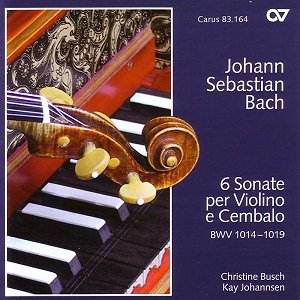First let's sort out
a few facts about Bach's Violin Sonatas.
Here is a set of six, the best known,
and the most performed. But a quick
check of the great man's oeuvre also
includes a Suite in A minor, an E minor
Sonata, also one in G major (BWV1021)
dating from c.1720 and one in C minor
(BWV 1024). These last two were recorded
by Andrew Manze on a BBC Music Magazine
disc in 1999 (well worth searching out).
Readers may possibly know of others.
The fact remains however that these
six sonatas are the most often recorded,
easily available in print and therefore
most regularly performed. They are all
early works dating from his period of
Bach’s work at Cothen from 1718 until
his move to Leipzig in 1723. This was
a particularly happy period for him.
He had just married Anna Magdalena after
the death of his first wife. Many of
his purely instrumental works seem to
date from this time.
The first five sonatas
are all in four movements: slow, fast.
slow, fast. The Second has a unique
'Dolce' marking for Movement 1 and ends
in a Presto. The last of the set is
in five movements: fast; slow, fast,
slow, fast. The middle one is, rather
curiously, for solo harpsichord and
one can't quite help wonder why Bach
inserted it, except to remind us that
these works are 'duos'. However if that
were the case then why not insert one
for solo violin!
It is true to say that
these sonatas do not stretch the instrument
as much as the solo sonatas and partitas,
nevertheless they are demanding works.
It should be remembered that Bach was
the first to write obbligato sonatas
like these, but we have no idea why
he wrote them.
Of especial musical
note I would mention the extraordinary
resemblance of the opening Largo, of
the Fourth Sonata both melodically and
harmonically to the famous aria in the
St Matthew Passion 'Erbarme dich, mein
Gott' a most moving movement. The first
movement of the Sixth Sonata in the
joyousness of its syncopations and melodic
inspiration seems the twin of the opening
of the Cantata 'Preis, Jerusalem den
Herrn' (c.1723)
To give you some idea
of Christine Busch and Kay Johannsen's
approach to these sonatas I will look
at the Second Sonata in A major. It
begins with a delicate 'dolce'. I love
the way the violinist caresses this
movement. In most of the other slow
movements she often brings a tear to
the eye with her sensitivity; these
are real arias for violinist. However
the ensuing Allegro and final Presto
I am far less keen on. The Allegro is
surely too slow and lacks excitement
and drive. The closing Presto is played
practically at the same speed as this
Allegro and fails to sustain interest.
The articulation is uninteresting. I
find myself wishing that someone had
shaken Busch and Johannsen out of their
lethargy.
The Sixth Sonata has
three Allegro movements and again, the
opening one especially, is too heavy
and slow. All of them are just too steady.
For this listener at least this approach
makes for uninteresting listening. The
First Sonata comes off best especially
the fearsome second movement.
According to the excellent
booklet notes Busch plays an instrument
from the Southern Tyrol and uses a baroque
bow. The harpsichord is a two manual
instrument built in 1999 by Keith Hill
of Michigan, USA. It has a bright sonority
which works well for Bach.
The recording is mostly
excellent if rather close, sometimes
slightly masking the harpsichord. The
booklet includes biographies of the
two performers and general notes by
Elsie Pfitzer. These are very useful.
She reminds us that "in this cycle the
harpsichord is expressly an equal partner
to the violin, as documented in the
title of the most important copies of
the autograph 'Sei Suonate a Cembalo
(con)certo e Violino solo'". Therefore
an equal balance and partnership is
what is most important.
Although I would not
want completely to put buyers off this
set I would recommend Carmignola and
Marcon (on Sony) or if you want piano
and not harpsichord you could try Tenebaum
and Kapp (on ESS.A.Y).
As you can see, I have
my reservations about Busch and Johannsen
but on the whole I shall be listening
again to their recordings and hopefully
enjoying much about them,
Gary Higginson


